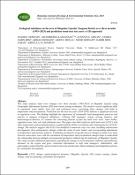Options
Ecological imbalance on the area of Shapahar Upazila, Naogaon district over three decades (1993÷2023) and prediction trend next ten years: a GIS approach
Journal
Romanian Journal of Ecology & Environmental Chemistry
ISSN
2668-8530
Date issued
2024-12-23
Author(s)
Hossain, Nazmul
Stamford University Bangladesh
Hassan, Ahammodullah
Islamic University
Adnan, Jannatul
Chowmuhani Govt. S A College, Bangladesh
Jahin Mim, Tasmia
BRAC University
Hossain, Arman
Molla, Ariful
Jagannath University
Hossain, Noor
University of Dhaka
Jahan, Habib Ibne
University of Dhaka
Al Mamun, Abdulla
Milestone College, Bangladesh
DOI
10.21698/rjeec.2024.211
Abstract
<jats:p>This study analyzes land cover changes over three decades (1993-2023) in Shapahar Upazila using Geographic Information Systems (GIS) and remote sensing techniques. The analysis reveals significant shifts in vegetation, water bodies, bare soil, and settlement areas, correlating these changes with shifts in temperature and precipitation. Predictions for the next ten years (2024-2033) indicate a significant increase in vegetation cover. The findings highlight the importance of sustainable land management practices and policies to mitigate ecological imbalances. Utilizing GIS strategies, remote sensing statistics, and meteorological datasets, we examine the converting patterns of four key land cover sorts: water bodies, vegetation area, bare soil, and settlement area. This paper also links Land use and Land cover (LULC) with other temperature and precipitation facts to understand the ability correlations and conjuring factors of LULC change. The analysis suggests that LULC has modified in numerous ways over time, including urbanization developments, flora enlargement, changes within the extent of water bodies, and corresponding adjustments in temperature and moisture patterns. Combining an analysis of specific percent changes in land cover types between consecutive years with the calculation of temperature and precipitation changes helps to understand the relationship between multiple environmental parameters influencing the landscape of Shapahar Upazila. Our study provides additional information regarding the changes in environmental conditions and landscape dynamics in the region and gives contextual information to help land managers, stakeholders, and policymakers understand the current trends in the area and develop climate mitigation and adaptation policies for sustainable development.</jats:p>
Files
Loading...
Name
Articol 11 Full.pdf
Size
477.35 KB
Format
Adobe PDF
Checksum
(MD5):267921a656109e9dae59048a691d51a9